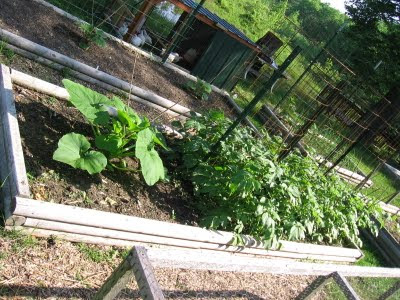Harvest for this week: Broccoli (one head) 9 oz; Kohlrabi 13 oz; Bok choi (one plant) 1 lb 10 oz; Lettuce (mixed) 6 oz. I’ve been going on about this broccoli –Major - in past posts, and can now say that the flavor is excellent, as good or better than any variety I've tried. I’ll definitely buy some more seeds from Pinetree. The so-called “baby” bok choi was a full plant with lots of stems that was starting to bolt. I went to the farmer's market in Bloomington on Saturday. The sticker shock reminded me why it's better to grow my own - the vendors are getting $4 for a bag of mixed greens, last year it was $3.
This garden has really come to life in the last few weeks, and this seems like a good time to put up pictures of each bed, a tour so to speak. The beds are limited to a small area that gets a full day of sun. A small garden like this takes a waste-no-space mindset.
The solanacae (tomato, pepper, eggplant) bed. This is a true summer bed, just getting started. You might notice there are some cole crops at one end of the bed, planted here because the brassica bed was full at the time. There is a Pink Brandywine and a German Queen tomato under the cages. I wanted Cherokee purple but couldn’t make it to the Bloominton farmers market on the 21st, so I ended up buying plants at Lowe’s. Yes the mainstream purveyors are now selling heirlooms. In front of each tomato cage is an eggplant, Fairy Tale and Lavendar Touch, which I started a little late. There are six pepper plants: Paprika, Hungarian Wax, Red Hot Cherry, Pimento, Giant Marconi, and Cubanelle. The Marconi is my favorite pepper, large and sweet, good on the grill.
The trapezoidal bed contains the brassicas. The cabbage family has been doing the heavy lifting so far this spring. Some of the earlier plantings have come out. There are seedlings in what looks like open spaces that are covered with straw to protect them from the heat. Sugar snap peas are growing up the trellis on the angled side. They got off to a slow start with the cloudy weather, and now it’s the heat. There’s one last set of brassicas still in pots that will go into the bed in about a week.
The parsnip bed. OK I really like parsnips. Nothing like digging up a batch in November and putting them in a pork roast. They were just thinned for the final time and should soon cover the bed with foliage. Parsnips are slow too start but are vigorous once established. There is a single row of leeks at one end, which shows I’m not completely coo-coo for parsnips.
The potato/summer squash bed. Everything in this bed is growing like its on steroids. The caged potatoes are Red Pontiac, the ones in front (by front I mean south) of the cages are Yukon Gold. The squash is a Sunburst pattypan, which really put on a growth spurt in the last week. Soon I’ll have to make plans to deal with the vine borer.
The winter squash bed. Two plants from Johnny’s seeds, a Metro Butternut and a Tiptop Acorn, will fill this bed. The butternut is the plant equivalent of an 800 pound gorilla. It will not only climb the trellis but cover the beds in front if I let it. The first year I got 25 nice size butternuts from one plant. The acorn is a much better behaved bush type. I planted the trellis with State ½ Runner beans, which are supposed to climb no more than three feet. I’ve given up on planting pole beans around here. Any bean plant above five feet high draws Japanese beetles in swarms, like plagues of locusts. The chickens are not camera shy.
The greens bed. This bed grew overwintered spinach and lettuce and was covered with a plastic greenhouse through the winter. Now it’s sort of a catchall bed. There’s still some lettuce, although after today there may not be. There’s one spinach (Space) which will probably bolt, some swiss chard, two half rows of carrots, parsley, savory, and cilantro. The spot that opened up in the center has Dragon Langerie bush beans putting out true leaves. My approach to beans now is to plant them into spots that open up in the beds, meaning there is no plan. I’ll try to spot plantings in different beds to stay ahead of the bean beetle.
The onion bed. It’s a mix of different kinds of onions – some Burpee’s and Ferry Morse yellow storage onions, as well as onions from sets, also Red Long of Tropea planted in groups of 2-3. There are four celery plants at one end and a single okra is planted at the other end. I haven’t had much luck with celery in the past, and am trying Golden Pascal this year. There are two cucumber plants going up the trellis. One is Diva, which has been very good in past years. The other is a Burpee’s variety called Pepino. I found the unopened seed packet in the drawer, dated 2009, and thought that one plant can’t hurt.
That’s it. Seven beds. Lots of vertical structure. I sure hope the sugar snaps make it through this hot spell.












































